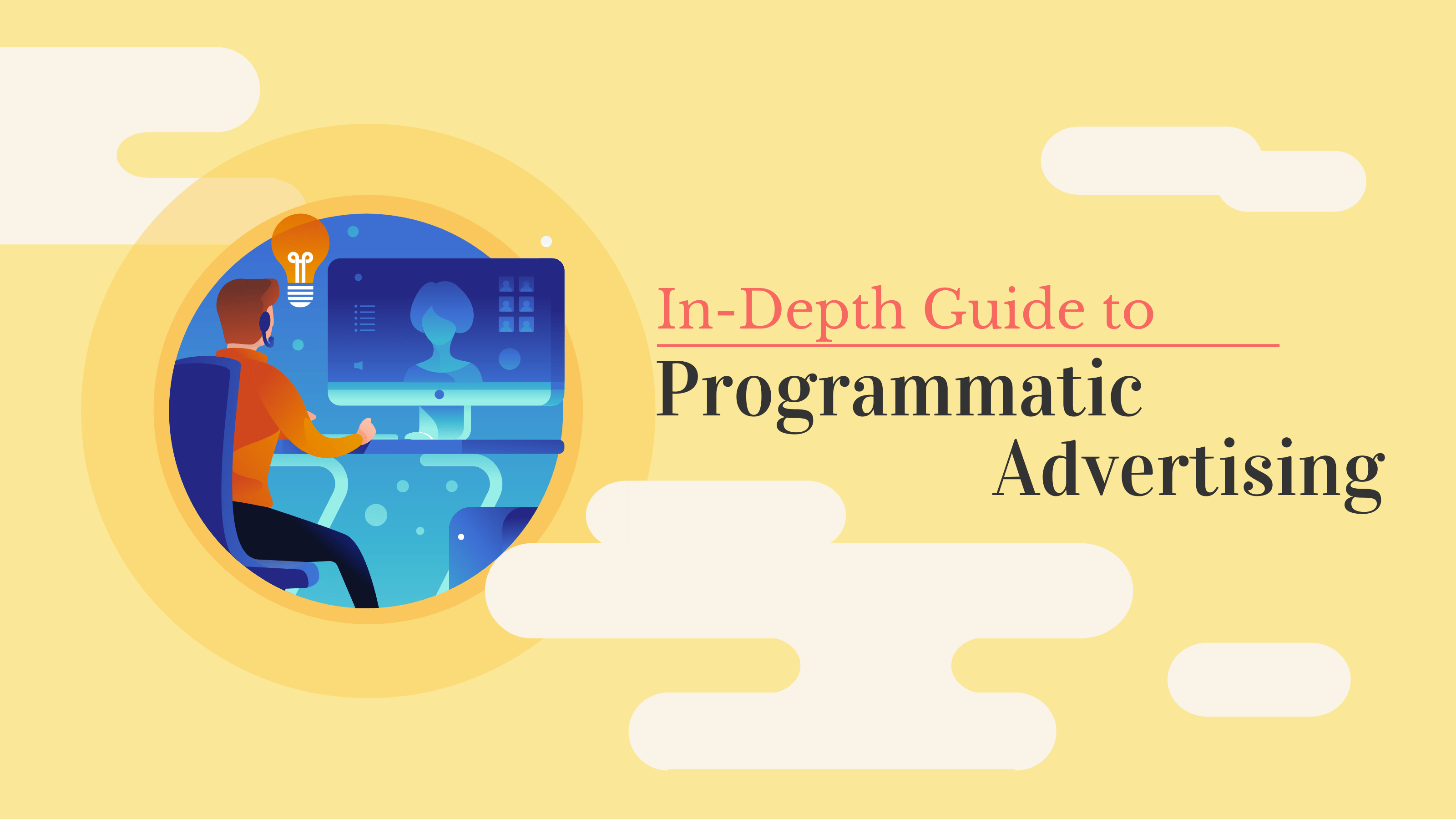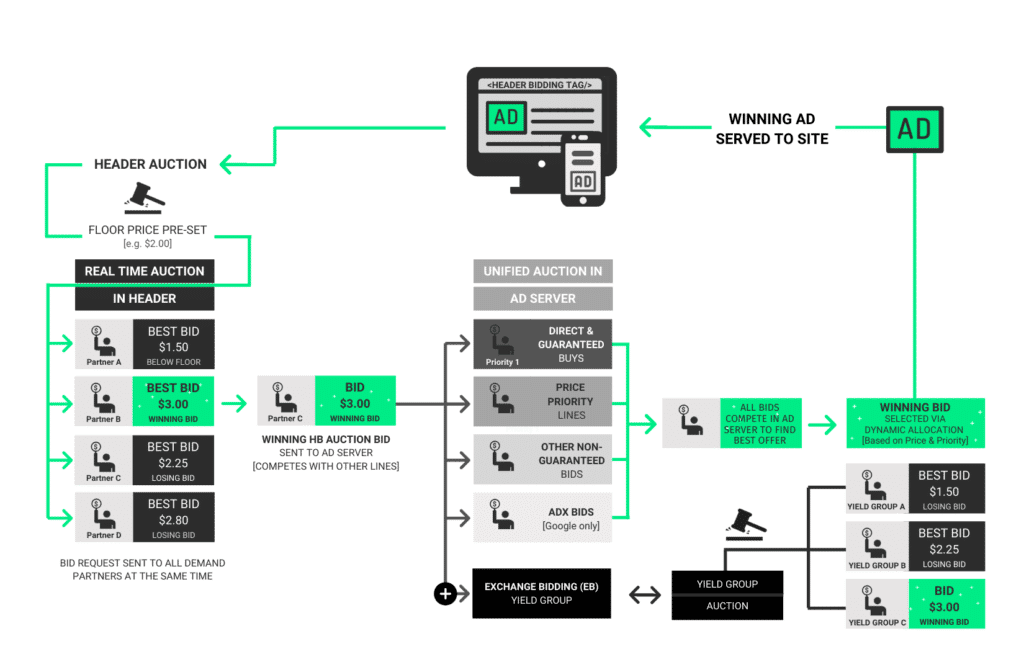If you’re new to programmatic advertising, you may be wondering what the hype is all about. Programmatic advertising is a way of buying and selling ad space automatically, through software.
In this in-depth guide, we’ll break down everything you need to know about programmatic advertising, including how it works, its benefits, and how to get started. By the end of this guide, you’ll be ready to start improving the efficiency of your marketing efforts.
What is Programmatic Advertising?
Programmatic Advertising is a digital marketing technique that uses software to automate the buying and placement of ads.
Machine learning and AI optimization will be used to replace human negotiations. For both the advertiser and the publisher, the goal is to promote efficiency and transparency.
Real-time auctions, in which advertising is bought as soon as a user arrives on a website, are used to monetize traffic. Real-time bidding (RTB) and programmatic direct ad buying are two types of programmatic ad purchasing.
Real-Time Bidding (RTB) vs. Programmatic Direct Ad Buying
RTB is a type of programmatic ad buying that allows advertisers to bid on ad impressions in real-time, as they become available.
Programmatic Direct is a type of programmatic ad buying that allows advertisers to buy ads directly from publishers, without going through an ad exchange.
Why Use Programmatic Advertising?
Programmatic advertising can be used to precisely target specific audiences and track the performance of ad campaigns in real-time. As a result, for many digital marketers, programmatic advertising has become the favored strategy.
Marketers have more time to optimize and develop ads with programmatic advertising, which leads to campaign success. The programmatic ecosystem includes ad exchanges, demand-side platforms (DSPs), supply-side platforms (SSPs), and data management platforms (DMPs).
Programmatic Ad buying gives marketers the ability to target specific audiences with laser precision and deliver relevant messages in real-time. This type of advertising has been shown to be more effective than traditional methods, and as a result, programmatic ad spending is expected to grow exponentially.
What is a Data Management Platform (DMP)?
In programmatic marketing, having the appropriate data is crucial.
A data management platform (DMP) is a self-contained system that collects, manages, analyzes, and activates data.
Advertisers can access detailed user profiles on the network. This information can then be used in a programmatic algorithm to match the best ad to the most likely to convert.
What is a Demand-Side Platform (DSP)?
For the advertiser side of the business, a DSP is a type of programmatic platform. Advertisers submit bids to a DSP, which then makes decisions on their behalf.
When merging users’ profiles and third-party data with advertising bids, the DSP decides which ad to show — and where to display it — when consumers visit a website. It must take into account the highest bidder’s bid, the ad’s content, and the advertiser’s cost.
How Do Publishers & Advertisers Utilize the DSP?
Publishers save and communicate information to the DSP via the pixel on a website in order to construct audience segments. Advertisers can utilize the DSP’s automated bidding feature to make sure their ads are shown to the right people.
When the DSP and Ad Exchange have decided which ad to match to which webpage, the SSP is notified.
Advertisers benefit from accurate ad placement, and publishers benefit from the winning bidder.
Is Google Ads a Demand-Side Platform (DSP)?
Google Ads (formerly Google AdWords) is a type of DSP, but it’s only limited to Google’s inventory.
Even though the Google Display Network has access to over 2 million websites, there are places where they have no reach. One of the main benefits of using a 3rd-party service DSP is that you get access to inventory that isn’t covered by Google’s ad network.
As an advertiser, you want to have access to as much inventory as possible in order to increase your chances of finding profitable placements.
Check out our Ultimate Guide To Managing AdWords article to learn more about managing your Google Adwords account.
What is a Supply-Side Platform (SSP)?
The inventory of a publisher is held by an SSP. After everything is confirmed on the Ad Exchange, the publisher submits a webpage as a source for an advertisement, and places a pixel code on their page to track visitor activity.
The code transmits no personally identifiable information (PII) about visitors or their activities. The SSP is designed to optimize the revenue that publishers receive from each ad impression (an impression being an instance of the ad being presented to someone).
The SSP is an invaluable tool for publishers and advertisers because it allows them to set different rates per ad space, as well as filter ads by the advertiser or other criteria.
Benefits of Programmatic Advertising
After the introduction of programmatic advertising, advertisers had access to more ad space than ever before. Before Programmatic advertising, 55% of the ad space was being left unsold at any time.
Automation has made this easier for advertisers by making it much simpler, less time-consuming, and less resource-intensive while enabling them to utilize more of the ad space that’s available to them. There are other important benefits that programmatic advertising provides, such as:
1. Higher Return on Investment (ROI).
A more streamlined process, with relevant ads that are served through targeting access to a large pool of publishers, means advertisers can get a better return on investment with less money spent.
2. Immediate Feedback and Real-Time Changes.
Advertisers can see how their ad is performing in real-time and make adjustments based on the number of impressions it has generated.
They can also target certain criteria, such as location or age range, within which they are looking for customers.
3. Scalability.
Instead of being limited by ad inventory, programmatic advertising allows advertisers to reach a broad audience by purchasing ad space from any accessible ad inventory.
4. Better Targeting.
Programmatic targeting can help advertisers better utilize their advertising budgets more efficiently.
5. More Relevant Ads.
Programmatic advertising allows advertisers to reach their desired audience by targeting people who are interested in the products or services being offered.
Advertisers can bid on specific keywords, which will show up on publisher sites with advertisements that are relevant to what they need and want.
There are 7 Auction Types for Programmatic Advertising
In addition to the auction techniques we’ve just discussed, direct methods of sale and purchase are also available, giving you even more influence over the process.
Different auction types available for programmatic advertising include:
1. Header Bidding
Publishers use Header Bidding to offer inventory to numerous ad exchanges at the same time before sending it to ad servers.
Publishers increase their income by increasing the competition by using header bidding.
2. Private Marketplace
A private marketplace, sometimes known as a non-guaranteed PMP contract, is an invite-only arrangement that allows publishers to limit their ad inventory to a small number of advertisers.
A private marketplace functions similarly to real-time bidding, except that publishers have more discretion over who they allow to advertise on their site. Publishers have complete control over who they invite to advertise on their websites.
Before the inventory is put to the open auction, they have the opportunity to bid in a small auction. Although a minimum price has been agreed upon, purchasers are free to bid on as many impressions as they wish.
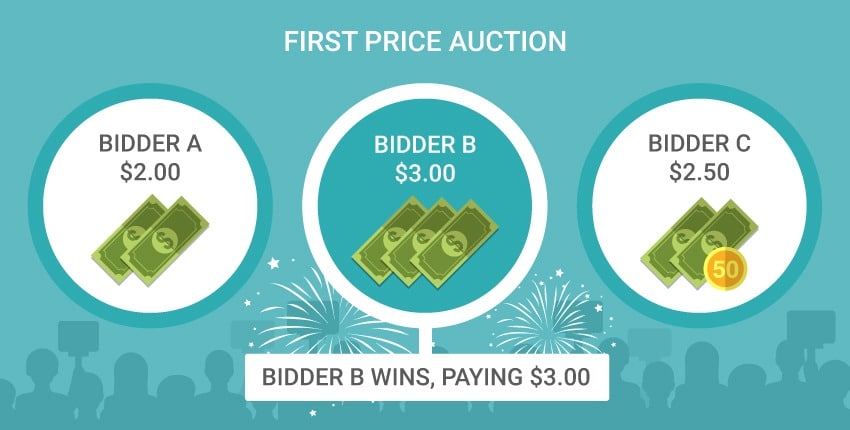
3. First Price Auction
Bidders participate in the auction simultaneously under the first-price auction model, and the highest bidder wins.
During the auction, the highest bidder pays the exact amount of their bid per thousand ad impressions (CPM).
The clearing price is another name for the winning bid.
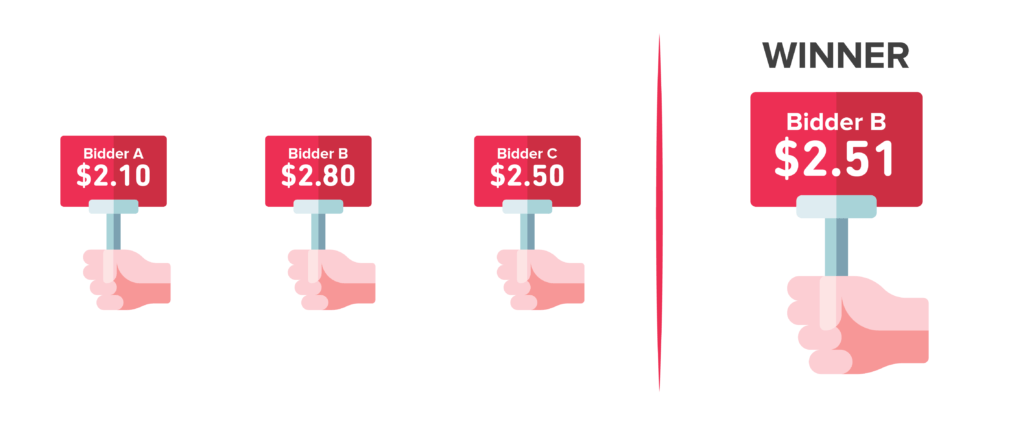
4. Second Price Auction
In a second-price auction, the highest bidder wins, just as in a first-price auction.
The final price, on the other hand, is only 0.01$ greater than the second-highest bidder’s bid rather than equal to the highest bid itself.
5. Exchange Bidding
Exchange Bidding is a server-side mechanism in which exchange networks and SSPs compete for ad inventory in a unified auction.
Google’s answer to header bidding is often referred to as exchange bidding.
6. Real-Time Bidding (RTB)
Supply-side platforms, or ad exchanges, run real-time auctions that take only milliseconds to complete.
7. Programmatic Guaranteed/Direct
In a reserve ad inventory sale, the advertiser or advertising agency negotiates directly with the publisher rather than using automation to replace the manual insertion order procedure.
Targeting is a type of programmatic advertising that does not need bidding, which helps to avoid fraudulent ad spaces.
The writer has control over the price of content, and consumers may get premium material directly from the publisher through an open system.
Is Programmatic Advertising “the Future of Ad Buying and Online Advertising”?
Yes, definitely.
While programmatic advertising is rising fast, it is impossible to tell what portion is now traded programmatically.
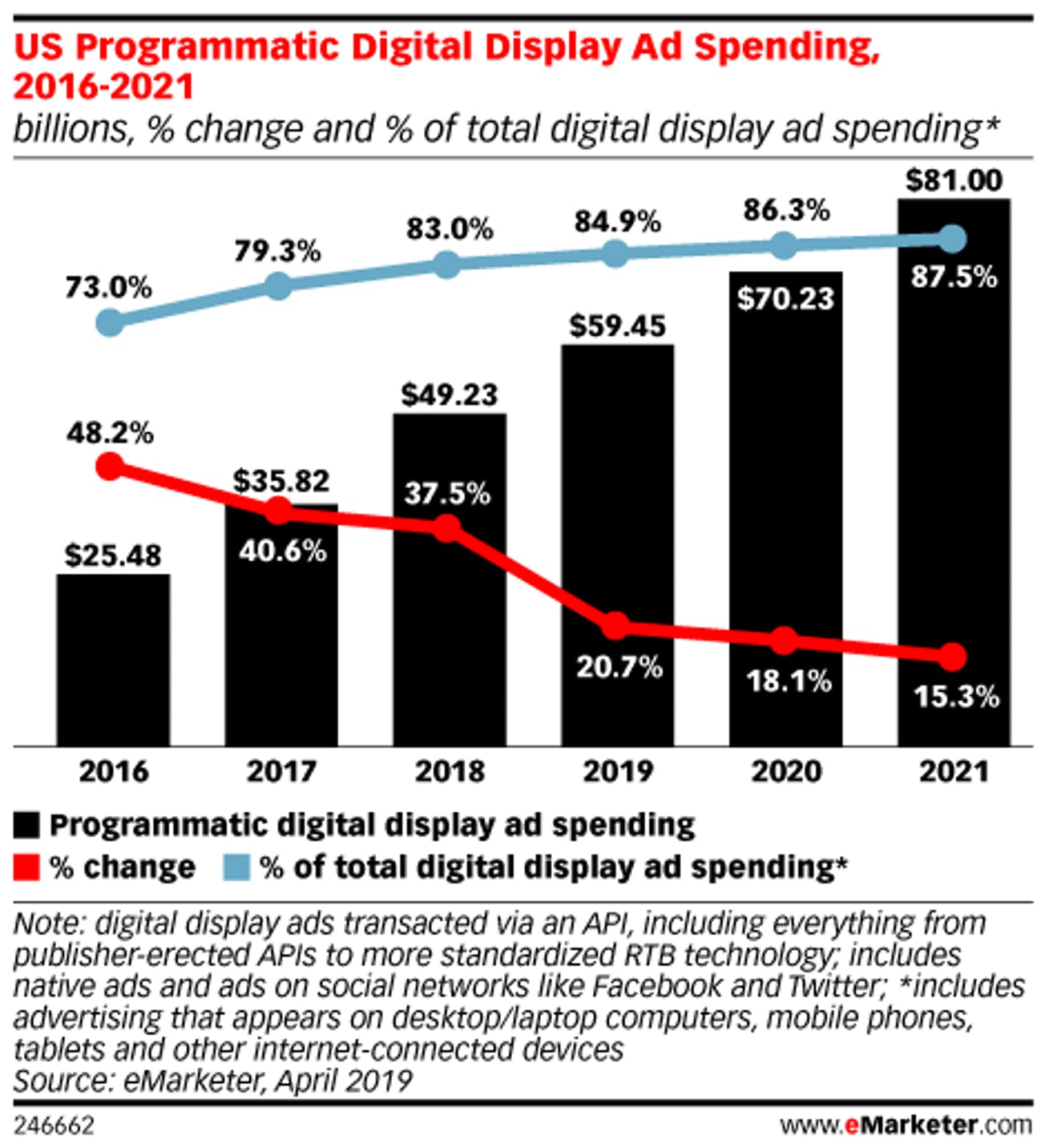
Some major brands have even built out-house teams to handle their programmatic media buying as well, so that they get a high ROI from programmatic advertising.
How Much Does Programmatic Advertising Cost?
In programmatic advertising, the CPM (Cost Per Mile) or Cost Per Impression method is employed. The cost per 1000 ad impressions on a website is known as the CPM.
Programmatic CPMs are typically estimated to be between $0.50 and $2. With Programmatic CPM, you can get a high-quality product for less money than with other platforms.
For example, on social media networks like Instagram, an average cost is around $6-$7 per thousand impressions!
However You Look at It, Programmatic Advertising is More Economical than Most Alternatives.
And the cost is determined by different variables, such as the type of Industry, Target Audience, Ad format, and placement on the page.
Use this calculator to get an estimation for your Programmatic Advertising Fees.
Conclusion: Is Programmatic Advertising Right For Your Business?
If you’re looking for a more efficient and effective way to target your audience with precision, programmatic advertising may be the answer. With real-time tracking of ad campaigns, you can fine-tune your efforts as you go to ensure that you’re getting the most out of your advertising dollars.
The future is bright for programmatic advertising and right now is an excellent time to get in on a rising trend. Accessibility has never been better, especially for smaller brands.
Ready to maximize your marketing efficiency? Contact us today and let us help get you started in this powerful form of digital marketing.
